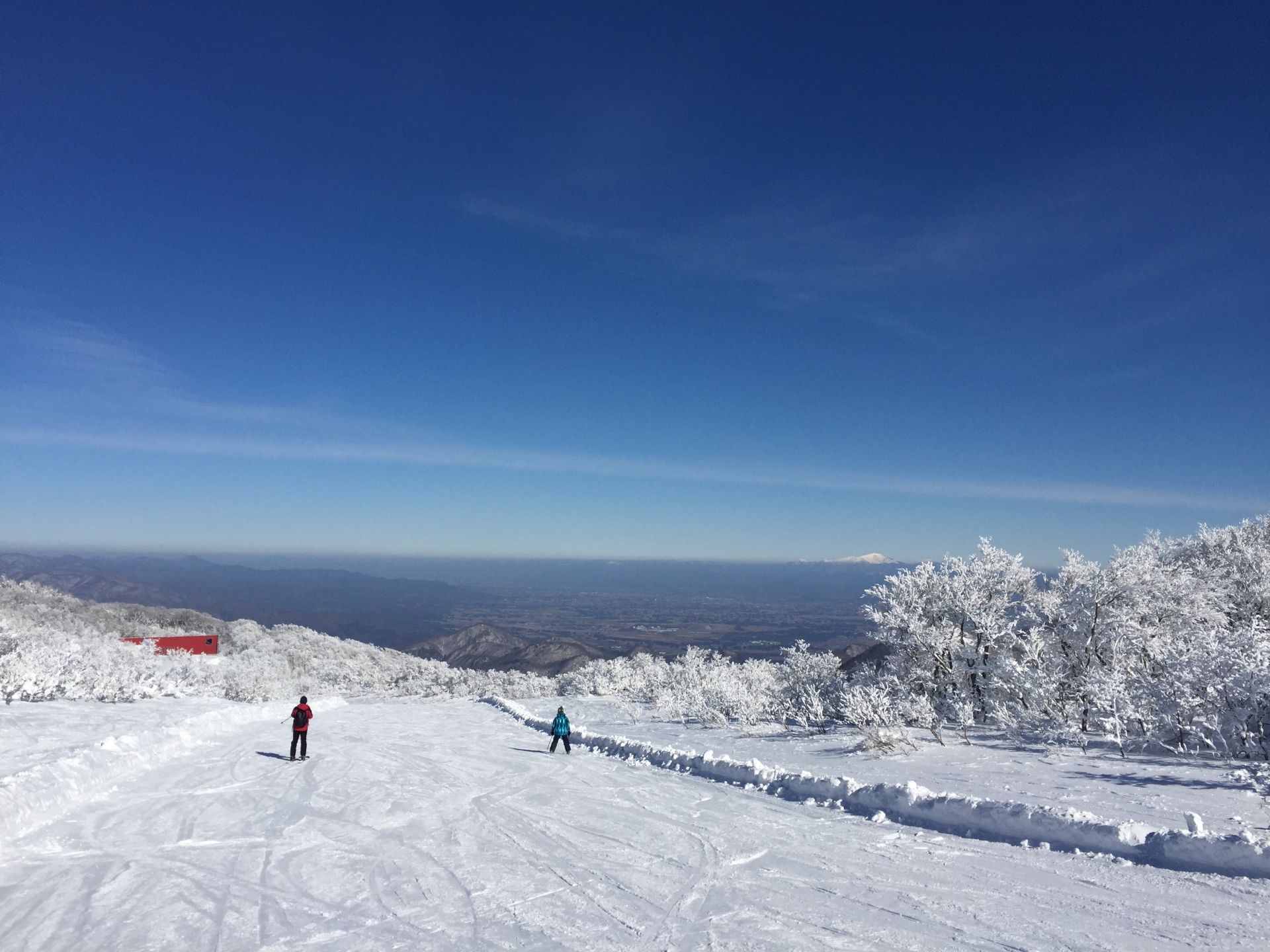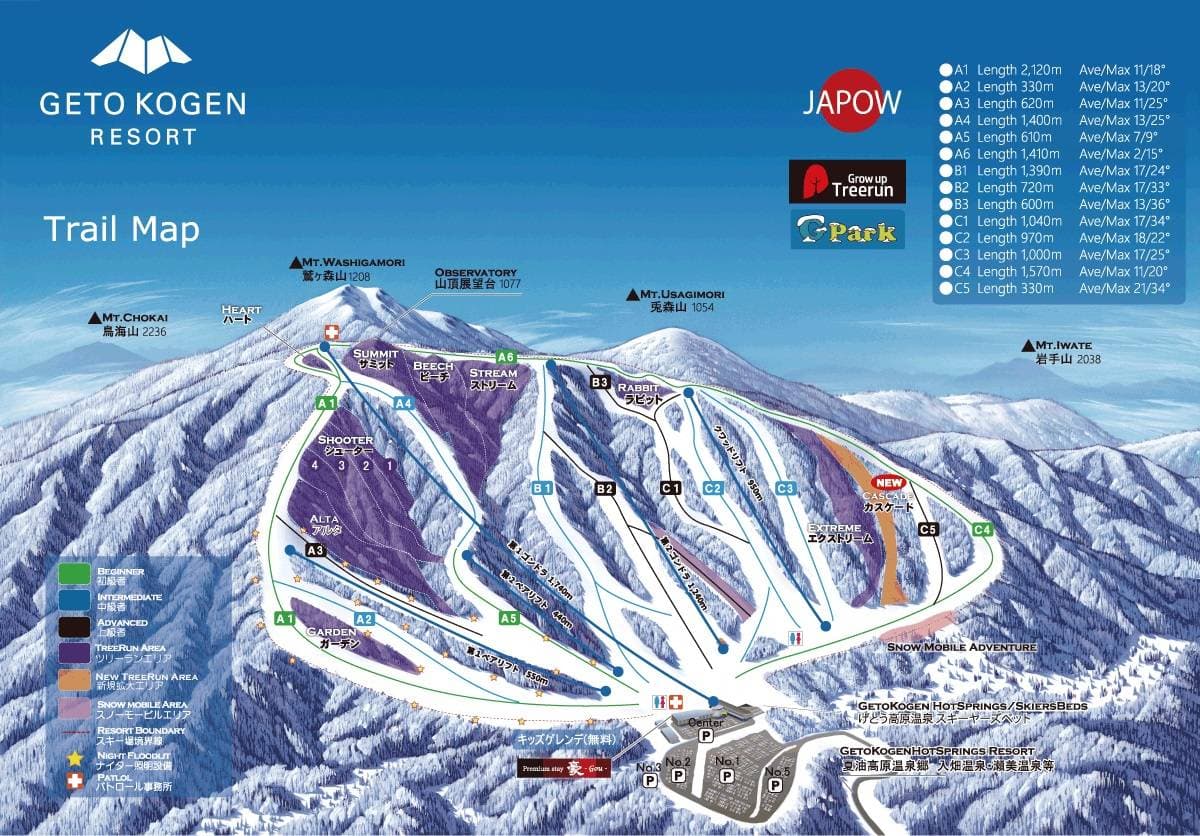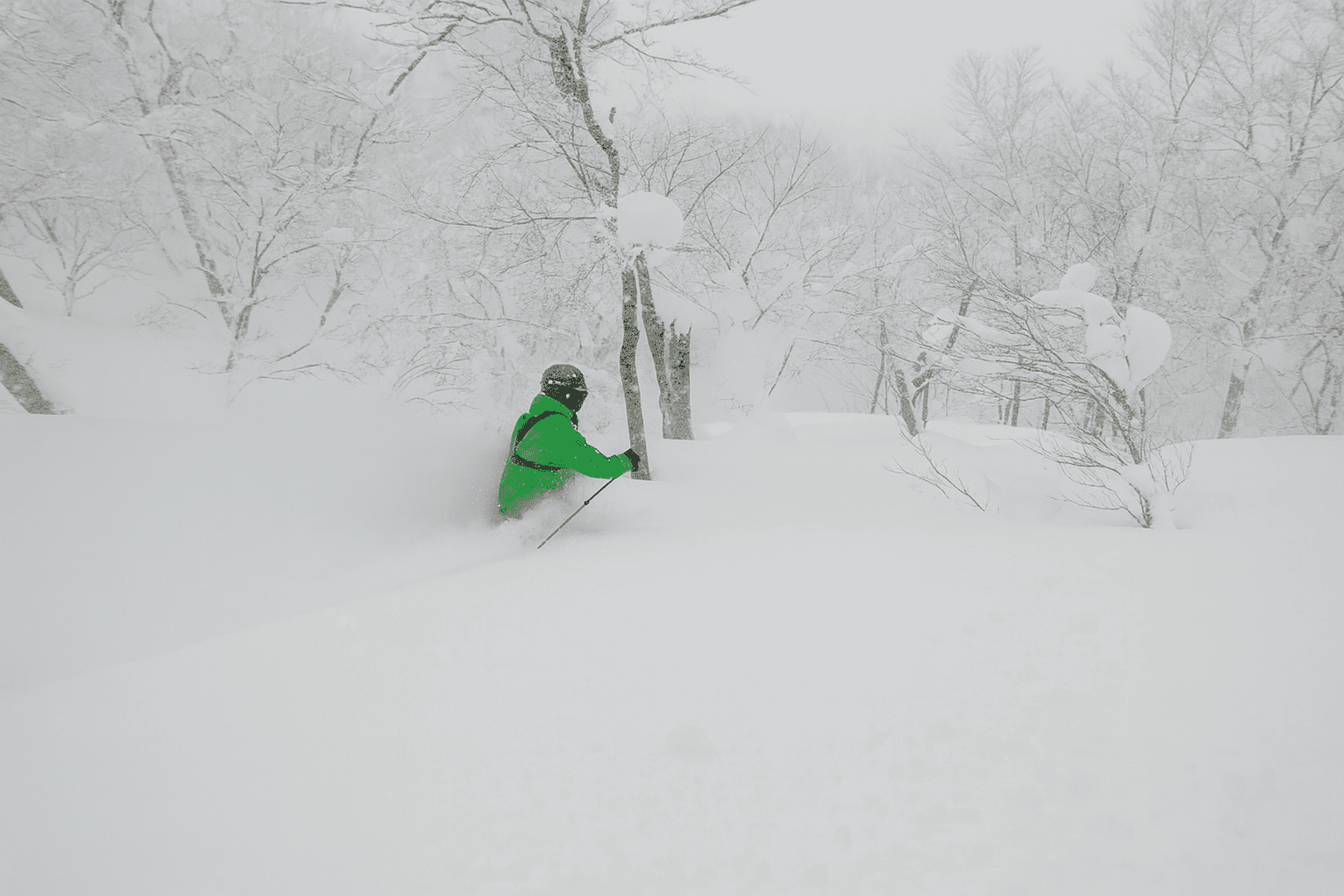Geto Kogen
The Tōhoku snow factory with trees that just keep giving

夏油
Storm Country, Big Smiles
Geto Kogen — “Geto” for short — sits in a snowy pocket west of Kitakami City. It isn’t a mega-resort or a scene; it’s a purpose-built snow machine surrounded by beech and birch, with the lifts, cafeteria, and onsen tucked into that notorious spaceship-like base building. When the northwest flow lines up across the Sea of Japan, this corner of Iwate just gets buried. Bluebirds are rare in mid-winter. Most days you’re riding under a ceiling of flakes and grinning.
History and vibe are straight Tōhoku. The hill opened in the early ’90s, rode the boom, survived the bust, and in the last decade doubled down on what it does best — deep snow and trees. The resort carved a network of official tree zones with marked entrances, set hours, and clear rules. That shift put Geto on the modern pow-hound map. It’s still mostly Japanese day-trippers mid-week, and you’ll hear more “otsukaresama” than English, but the word is out among international riders who want the real Japan with the snow to match.

Terrain is compact on paper and sprawling in practice. The map shows 14 named courses and 430 m of vertical from 1,070 m down to 640 m. The feel on a storm cycle is bigger: gullies, ribs, little spines and old-growth corridors that ride like a choose-your-own adventure. Steeps are short, yes, but they stack into satisfying top-to-bottom stories — line the entrance, pop a rollover, surf the trench, and milk the sidewalls of a groomer back to a lift that almost never has a wait.
This is not an internationalized resort with English everywhere or an army of foreign instructors. It’s friendly and functional. Queues are orderly, signage is simple, and if you make the effort with a few phrases or a smile, staff will meet you halfway. Prices are fair by Japanese standards — lift tickets are mid-range, dorm beds and onsen stays are reasonable — and food, whether you eat at the dome or in Kitakami, is tasty and well-priced. Weekends bring more locals and families, but even then, powder lingers where the trees get tight.
Resort Stats
- Vertical430m (1070m → 640m)
- Snowfall~15m
- Terrain 40% 40% 20%
- Tree Riding
- Lift Pass$41
- Lifts2 gondolas, 1 hooded quad, 2 pairs
- Crowds
- Out of BoundsLimited
- Night Skiing
- Family Friendly
- Trails14
- Skiable Area~90ha
- VibeDeep, disciplined, tree-obsessed
Trail Map

Powder & Terrain
Geto’s snow has a signature feel — light enough to blow over your boots on colder cycles, with a bit of coastal creaminess on warmer pulses that lets you push hard without worrying the base. Coverage builds fast. By New Year, the base is classic Tōhoku deep, and patrols start opening more of the tree network. Expect refills throughout a storm day, and don’t be surprised if your morning line looks fresh again after lunch.
The lift network is purposely simple: No. 1 Gondola, No. 2 Gondola (often weekends and holidays), a hooded Quad, and the No. 1 and No. 2 Pair chairs. That mix spreads skiers well — the gondolas cycle the main vertical, the quad feeds the C-zone, and the pairs handle learners and night riding. On busy Saturdays the second gondola helps relieve pressure; on weekdays you’ll often ski straight on. Wind holds do happen in foul weather, but the hill’s orientation keeps the core lifts turning more often than not.

On piste, you’ll find long cruising blues in A- and C-zones (A1, C3, C4) and spicy ungroomed blacks like B2 and B3 that go steep up top before mellowing to exits. The star of the show, though, is the official tree-run system. Think named zones with marked entries, hazard boards, and set hours — typically 9:30 to 14:00 — that open progressively as patrol digs out. Classics like Shooter 1–4 peel off A-zone ridges into natural half-pipes; Beech strings together big-trunked corridors with a flowing midsection; Extreme and Cascade sit between C3 and C5 for storm-day stealth; Alta rides like a playful mini-park of rolls and gullies. Entrances are obvious when open, and you’ll see gates closed when hazard spikes.
Backcountry here is not a casual rope-duck. Outside the controlled area, you’re on your own. The resort posts clear rescue policies and expects self-reliance — this is real mountain terrain with cornices, creeks and steep sidewalls that load during reset cycles. If you want to venture beyond, book a guide or save it for another venue on your trip. The good news is you don’t need to leave the ropes to ski legitimately deep lines; the tree zones exist to scratch that itch while keeping traffic contained and rescue logistics sane.
Crowd dynamics are a gift. Weekdays are blissfully quiet, with a locals-only feel and soft snow hanging in the trees deep into the afternoon. On weekends and during New Year holidays, the base gets lively, beginner areas fill, and the gondolas see a proper queue at open — but shockingly few people push into the deeper tree shots, especially once the steeper entries get tracked. Even on popular days, there’s powder in Beech’s mid-section and on the apron below Shooter if you’re patient.
Local tips from years of chasing storms here: when it’s nuking, start with A4 → Shooter 1–4 and B2 to suss the wind effect; if visibility goes flat, dive Beech or Extreme where the trees give contrast; if the second gondola is turning, steal a couple A6 laps for variety and a look at the ridgeline. Watch timing — tree areas open later than the groomed runs — so harvest early snow on the ungroomed piste (B3, C1) while patrol finishes their checks, then swap to your favorite zone. Boarders, heed the resort’s advice and ride in pairs in the deeper gullies; some exits flatten and can bog you after a big refresh.
Who's it for?
Pow chasers who love trees will thrive. Advanced riders get a playground of short, punchy entries into real-deal zones with enough pitch to keep it spicy and enough density to cushion the learning curve. Strong intermediates who want to progress off-piste will appreciate how the steeps are short and the runouts are forgiving — you can build confidence without burning a whole day hiking.
If your heart needs massive alpine bowls, super-long steeps, parks, or a full Western village scene, you’ll find the envelope here modest. Geto is a specialist — deep snow, trees, repeat — and it excels in that lane.
Accommodation
Base-area dorms and onsen life. At the resort you’ll find simple dormitory options in the main complex — think bunk beds, warm drying rooms, big baths, and first-tracks convenience. It’s ski-in in spirit: roll out, stash your gear, and you’re a minute from the gondola. Breakfasts are hearty, dinners are set-menu or small buffet, and there’s usually a communal vibe in the lounge. It’s not luxury, it’s functional, and it’s exactly right for riders who prioritize snow time.
Classic ryokan soaks. Down the road, Irihata Onsen delivers that old-school soak-sleep-repeat rhythm with shuttle access in winter. Rooms are simple, baths are the star, and the setting along the river feels properly rural. Price-wise, it’s friendly compared to big-name destinations, and kaiseki dinners are a welcome reset after a storm day. Expect earnest hospitality and little English — bring a phrasebook app and you’ll be fine.
City base in Kitakami. If you want more dining choice and nightlife, stay in Kitakami (about 45–60 minutes with winter roads or shuttle). Business hotels and small inns cluster around the station; rates are gentle mid-week. You’ll trade a longer morning commute for great izakaya wandering at night and easy access to trains and convenience stores. For mixed groups, that flexibility can be perfect — deep days at Geto, then a city dinner run.
Food & Après
On-mountain eats are reliable, fast and warm — curry rice, ramen, karaage bowls, and the kind of soft-serve Hokkaidō is famous for. Grab a tray, load up, and warm your hands before heading back out. Coffee and cocoa at the café window are clutch when it’s dumping sideways.
Après is mellow by design. This is a soak-and-sleep mountain. If you’re staying at the base, the onsen is the move — outdoor bath, steam rising into the snow, and legs turning to jelly in the best way. In Kitakami, make it a food tour: grilled yakitori skewers, bowls of miso-rich ramen, and local sake in small counter bars. It’s not a party town, but it’s tasty, friendly, and authentic.
Getting There
Closest airport: Hanamaki (HNA) works if you’re routing domestically; most international travelers fly into Sendai (SDJ) or Tokyo (NRT/HND), then take the Tohoku Shinkansen to Kitakami Station. From Kitakami, the resort runs a free winter shuttle on a timetable — or you can rent a car.
By car: From Kitakami IC, it’s about 40–60 minutes depending on snowfall. Roads are maintained but can be slick; winter tires are a must and common on rentals. If the last climb looks hairy, use the satellite parking in the valley and hop the shuttle up — easy, stress-free, and recommended in heavy snow.
Pro tip: Base yourself in Kitakami with a rental car if you want options. When storms hammer the coast, Geto fires; if winds get spicy or you want a change of pace, you can strike out to Appi, Shizukuishi, or Hachimantai on clearer days.
Japow Travel Tips
- Lift hours: Day operations typically around 8:30–16:30; No. 1 Gondola often starts at 9:00. Night skiing runs some evenings on the No. 1 Pair until 20:00.
- Tree-run hours: Official zones generally 9:30–14:00 and open progressively as patrol completes checks.
- Safety & OB: Outside the controlled area is self-responsibility. The resort is explicit about rescue costs and will revoke passes for prohibited zones. Inside the ropes, the tree system exists so you don’t need to poach.
- Snow patterns: Peak reset window runs January to early March; quality swings from ultra-dry to slightly coastal depending on air temps and wind.
- Language: English is limited. Booking, rentals, and basic purchases are easy; lessons are mostly in Japanese.
- Crowds: Light mid-week; weekends and holidays see a morning pulse at the gondolas, then dispersion.
- Nearby resorts: For variety on clearer days, tag Appi Kogen, Shizukuishi, Hachimantai Shimokura, or Amihari.
Verdict: Deep trees, disciplined fun
Geto is a specialist’s mountain — storms, trees, repeat — and that’s exactly why it belongs on your Honshu itinerary. When the snow machine flips on, the hill rides larger than its stats, with officially managed glades that feel like a private stash farm. If you’re the type who measures a trip by how often you’re ducking into old-growth corridors with a goofy grin, Geto’s for you. Pack your snorkel, respect the rules, and enjoy the reset.